ORGANIZATION
Cavalry regiments during this period usually consisted of eight squadrons each of which averaged 125 men. Exceptions to this were the Lifgardet till Hast of six squadrons; the Lifregementsbrigadens kyrassiercorps of four squadrons; and the Karelske dragoncorps of two squadrons. Regiments of six or more squadrons were divided into two battalions with the odd numbered squadrons in the first battalion and even numbered squadrons in the second battalion. During active military operations one or two squadrons of the larger regiments were left in the home area as a replacement depot.
UNIFORMS AND EQUIPMENT
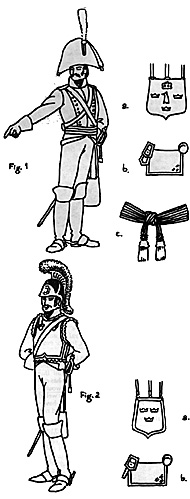 Norra Skanska kevaleriregemente 1801;
Skanska liniedragonregemente 1802 (Fig 1.):
Bicorne black with white plume, yellow braid and button,
red macaroons, and a red pompom with a white center.
Coat yellow as are the shoulders/raps, collar dark blue
trimmed red, dark blue lapels, turnbacks yellow trimmed
dark blue, brass buttons, black neck cloth. Sash yellow
and blue striped with yellow tassels (Fig 1c.). Breeches
and belts yellow ocre or buff, buckles brass. Boots black
with steel spurs. Scabbard black with steel fittings. Sabre
hilt steel, dragonne yellow. Sabretache dark blue with
yellow eagle and crowns, straps black (Fig 1a.).
Norra Skanska kevaleriregemente 1801;
Skanska liniedragonregemente 1802 (Fig 1.):
Bicorne black with white plume, yellow braid and button,
red macaroons, and a red pompom with a white center.
Coat yellow as are the shoulders/raps, collar dark blue
trimmed red, dark blue lapels, turnbacks yellow trimmed
dark blue, brass buttons, black neck cloth. Sash yellow
and blue striped with yellow tassels (Fig 1c.). Breeches
and belts yellow ocre or buff, buckles brass. Boots black
with steel spurs. Scabbard black with steel fittings. Sabre
hilt steel, dragonne yellow. Sabretache dark blue with
yellow eagle and crowns, straps black (Fig 1a.).
Saddle cloth and pistol covers dark blue trimmed yellow, three Swedish crowns yellow, portemanteau dark blue (Fig 1b.). NOTE: This regiment was converted to a hussar regiment in 1807 and renamed th. Skanska husarregement (see below).
Sodra Skanska kavaleriregement 1801; Skanska karabinjarregemente 1805 (Fig 1.): Bicorne black with white plume and pompom, the braid, button and macaroons yellow. Coat, shoulders/raps, and lapels dark blue, collar and turnbacks sulpher yellow, buttons brass, neck cloth black. Gloves, breeches, and belts yellow ocre or buff, buckles brass. Sash yellow and blue striped with yellow tassels (Fig 1c). Boots black spurs steel. Scabbard black with steel fittings. Sabre hilt steel, dragonne yellow. Sabretache dark blue with yellow eagle and crowns, straps black (Fig 1a.). Saddle cloth and pistol covers dark blue trimmed yellow three Swedish crowns yellow, portemanteau dark blue (Fig 1b.).
During the 1813 campaign in Germany an eyewitness described this regiment as being dressed entirely in yellow. This would seem to indicate that a yellow jerkin was worn in place of the dark blue coat while on campaign. In 1814, while in Belgium, the regiment received a new uniform. A black Russian kiver shako with black plume, and yellow cords, plaque, chin straps and pompom was issued. A short dark blue coat without tails, dark blue collar and cuffs sulpher yellow lapels and turnbacks, brass buttons. A hussar sash blue and yellow striped with yellow runners and cord. Cavalry overalls of dark blue cloth with a yellow seam stripe and false black boots (Fig 1a ) All leather was black, and metal brass. Sabretache black with three Swedish crowns in yellow.
Lifregementsbrigadens kyrassiercorps (Fig 2.): Helmet black with peak, plaque, visor, and reinforcing bands brass, chenille black. Coat and breeches yellow ocre skin, collar and turnback trim dark blue. Neck cloth black. Cuirass steel with brass fittings, ruffles in dark blue cloth. Belts and gloves yellow ocre.
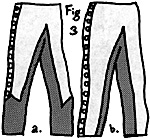 Boots black with
steel spurs. Scabbard brown with brass fittings. Sabretache
dark blue trimmed yellow with three yellow Swedish
crowns, straps black (Fig 2a.). Saddle cloth and pistol
covers dark blue trimmed yellow, crowns yellow,
portemanteau dark blue (Fig 2b.).
Boots black with
steel spurs. Scabbard brown with brass fittings. Sabretache
dark blue trimmed yellow with three yellow Swedish
crowns, straps black (Fig 2a.). Saddle cloth and pistol
covers dark blue trimmed yellow, crowns yellow,
portemanteau dark blue (Fig 2b.).
Cavalry overalls were often worn. They were dark blue with yellow buttons (fig 3b.).
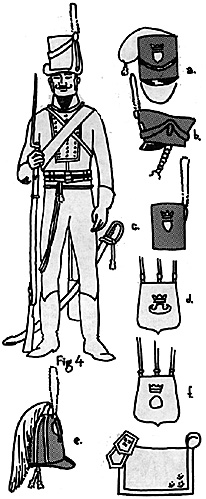 Smalands latta dragonregemente (Fig 4.):
During the period 1801-1814 this regiment wore four
different types of headgear. 1801-1805 (Fig 4.): Black
infantry style hat with braid, button, and oblique lace yellow,
plume white, and pompom crimson. 1806-1810 (Fig 4c.): A
black so called "dragonmossa", white plume, yellow cord,
brass plate and crown. 1810-1813 (Fig 4a.): Tolpak or
busby of brown or black fur with visor, yellow bag with white
tassel, cords and tassels yellow, plate and crown brass.
1813-1814 (Fig 4b.): A black Russian kiver shako with red
cords, white metallic plate, yellow pompom, and white
plume. The remainder of the uniform remained standard
throughout the period. Jacket without tails dark blue,
shoulders/raps dark blue, collar yellow, lace on the half
lapels, lower half of the front of the jacket, and around the
base of the jacket yellow, buttons brass, neck cloth black.
Hussar sash blue and yellow striped, runners yellow with
vertical blue stripes, cords yellow and blue intermixed.
Smalands latta dragonregemente (Fig 4.):
During the period 1801-1814 this regiment wore four
different types of headgear. 1801-1805 (Fig 4.): Black
infantry style hat with braid, button, and oblique lace yellow,
plume white, and pompom crimson. 1806-1810 (Fig 4c.): A
black so called "dragonmossa", white plume, yellow cord,
brass plate and crown. 1810-1813 (Fig 4a.): Tolpak or
busby of brown or black fur with visor, yellow bag with white
tassel, cords and tassels yellow, plate and crown brass.
1813-1814 (Fig 4b.): A black Russian kiver shako with red
cords, white metallic plate, yellow pompom, and white
plume. The remainder of the uniform remained standard
throughout the period. Jacket without tails dark blue,
shoulders/raps dark blue, collar yellow, lace on the half
lapels, lower half of the front of the jacket, and around the
base of the jacket yellow, buttons brass, neck cloth black.
Hussar sash blue and yellow striped, runners yellow with
vertical blue stripes, cords yellow and blue intermixed.
Breeches, gloves and belts yellow ocre or buff. Waistbelt black, buckle brass. Carbine sling yellow ocre or buff. Boots black. Sabretache black, plaque brass, straps black (Fig 4d.). Scabbard steel, dragonne yellow ocre or buff. Carbine fittings brass. Cavalry overalls dark blue with a double yellow stripe down the seams (Fig 3b.). Saddle cloth and pistol covers dark blue trimmed yellow, three crowns yellow. Portemanteau dark blue (Fig 4g.).
Vestgota liniedragonregemente (fig 4): This regiment wore essentially the same uniform, with the exception of headgear, as the Smalands latta dragonregemente. Helmet black leather with brass fittings, white horsehair down the back of the helmet, red pompom, white plume, yellow disc and loop, yellow cords and tassels. Dark blue jacket without tails, collar and cuffs red, shoulderboards dark blue. White lace around the lapels, down the front, and around the base of the jacket, buttons brass, neckcloth black. Hussar sash yellow with yellow cords. Breeches and gloves yellow ocre or buff. Belts white, buckles brass. Boots black. Scabbard brass, dragonne yellow. Cavalry overalls white. Saddle cloth and pistol covers dark blue trimmed yellow, three crowns yellow. Portemanteau dark blue (Fig 4g.). It is not known if this regiment wore a sabretache. NOTE: In 1811 this regiment was converted into an infantry regiment.
Nylands dragonregemente (Finnish) (Fig 4): The uniform of this regiment was essentially the same as the 1806-1810 uniform of the Smalands latta dragonregemente. Black "dragonmossa" (Fig 4c.), white plume, yellow cord, white metal plaque. Dark blue jacket without tails, shoulders/raps dark blue, collar dark blue trimmed yellow, yellow trim on lapels, down the front, and around the base of the jacket, buttons brass, neckcloth black. Hussar sash and cords yellow. Breeches, gloves, and belts yellow ocre or buff, buckles brass. Boots black. Carbine fittings brass, sling red. Sabretache (Fig 4f.) black with white metal plaque and crown, straps buff. Scabbard steel, dragonne yellow. Saddle cloth and pistol covers (Fig. 8a.) dark blue trimmed with two white bands. NOTE: With the annexation of Finland by Russia in 1809 this regiment was disbanded.
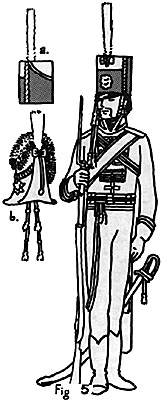 Latta Lifdragonregemente 1801; Lifgardet till
Hast 1806 (Fig 5): 1801-1806 Light yellow shako with
a black flame or wing which was worn wrapped around the
shako and held in place by the front plate, plume, braid, and
button white, cord on the left white, cord on the right red,
tassels green, raquettes red, cockade greenwhite-red, plate
white metal. 1807-1810 Black kusket similar in appearance
to the Guard kusket, plume, braid, and six-pointed star
white, cord gold or yellow, cockade sky blue, chenille
black, cords, raquettes, and tassels red (Fig 5b.). In 1811
the headgear returned to that of the 1801-1806 period.
Jacket without tails white, collar white trimmed sky blue,
shoulderstraps white, half-lapels sky blue, buttons silver,
button lace on the half-lapels white, the lower button lace is
white trimmed sky blue, as is the lace on the base of the
jacket. Hussar sash yellow and blue striped, l runners yellow
with vertical blue stripes, cords and tassels yellow and blue
mixed. Gloves yellow ocre or buff with a border of two black
stripes. Breeches of yellow ocre or buff skin. Belts yellow
ocre with a border of two black stripes, buckles white metal.
Sabretache (Fig 2a.) sky blue trimmed white, crowns yellow,
straps yellow or buff with a double black border. Scabbard,
sabre hilt and fittings steel, dragonne yellow with black trim.
Boots black. Carbine sling red. Saddle cloth and pistol
covers (Fig 4g.) sky blue with white trim and crowns.
Portemanteau sky blue.
Latta Lifdragonregemente 1801; Lifgardet till
Hast 1806 (Fig 5): 1801-1806 Light yellow shako with
a black flame or wing which was worn wrapped around the
shako and held in place by the front plate, plume, braid, and
button white, cord on the left white, cord on the right red,
tassels green, raquettes red, cockade greenwhite-red, plate
white metal. 1807-1810 Black kusket similar in appearance
to the Guard kusket, plume, braid, and six-pointed star
white, cord gold or yellow, cockade sky blue, chenille
black, cords, raquettes, and tassels red (Fig 5b.). In 1811
the headgear returned to that of the 1801-1806 period.
Jacket without tails white, collar white trimmed sky blue,
shoulderstraps white, half-lapels sky blue, buttons silver,
button lace on the half-lapels white, the lower button lace is
white trimmed sky blue, as is the lace on the base of the
jacket. Hussar sash yellow and blue striped, l runners yellow
with vertical blue stripes, cords and tassels yellow and blue
mixed. Gloves yellow ocre or buff with a border of two black
stripes. Breeches of yellow ocre or buff skin. Belts yellow
ocre with a border of two black stripes, buckles white metal.
Sabretache (Fig 2a.) sky blue trimmed white, crowns yellow,
straps yellow or buff with a double black border. Scabbard,
sabre hilt and fittings steel, dragonne yellow with black trim.
Boots black. Carbine sling red. Saddle cloth and pistol
covers (Fig 4g.) sky blue with white trim and crowns.
Portemanteau sky blue.
 In December, 1813 this regiment received a new
uniform which resembled in appearance the Russian hussar
uniform of the same period (Fig 6). Black Russian kiver
shako with cords, ornaments, chin straps and plume white,
pompom red with a yellow cross, cockade yellow. Dolman
sky blue with collar and cuffs white buttons silver, braid
white. Pelisse white with black fur, buttons silver, braid
white. Hussar sash blue and yellow striped, runners yellow with vertical blue stripes,
cords blue and yellow mixed. Cavalry overalls sky blue with
a white stripe down the seams and silver buttons,
sheepskin lining and false boots black (Fig 3a.). Belts
black, buckles brass. Sabretache sky blue with white lace
and crowns, straps black. Scabbard, sabre hilt steel,
dragonne yellow with black trim. Saddle cloth,
unknown, but probably as figure 7d., sky blue with white
trim. Portemanteau sky blue.
In December, 1813 this regiment received a new
uniform which resembled in appearance the Russian hussar
uniform of the same period (Fig 6). Black Russian kiver
shako with cords, ornaments, chin straps and plume white,
pompom red with a yellow cross, cockade yellow. Dolman
sky blue with collar and cuffs white buttons silver, braid
white. Pelisse white with black fur, buttons silver, braid
white. Hussar sash blue and yellow striped, runners yellow with vertical blue stripes,
cords blue and yellow mixed. Cavalry overalls sky blue with
a white stripe down the seams and silver buttons,
sheepskin lining and false boots black (Fig 3a.). Belts
black, buckles brass. Sabretache sky blue with white lace
and crowns, straps black. Scabbard, sabre hilt steel,
dragonne yellow with black trim. Saddle cloth,
unknown, but probably as figure 7d., sky blue with white
trim. Portemanteau sky blue.
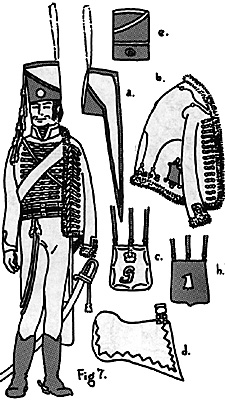 Mornerska husarregemente (Fig 7):
Mirliton dark blue or black base, yellow top and flame,
the top is bordered in dark blue or black, plume white,
disc, cords, raquettes and tassels red. The border of the
flame is yellow. Sometime between 1806 and 1813 the
flame was changed to dark blue or black trimmed yellow,
and the disc became yellow with a red center. During the
1813-1814 campaigns the flame was worn wrapped around
the cap (Fig 7e.). Dolman dark blue with brass buttons and
yellow braid. In 1806 the braids numbered ten, in 1813 the
number of braids increased to fourteen. Collar dark blue
trimmed yellow, cuffs yellow, lace yellow, neckcloth Yellow.
Mornerska husarregemente (Fig 7):
Mirliton dark blue or black base, yellow top and flame,
the top is bordered in dark blue or black, plume white,
disc, cords, raquettes and tassels red. The border of the
flame is yellow. Sometime between 1806 and 1813 the
flame was changed to dark blue or black trimmed yellow,
and the disc became yellow with a red center. During the
1813-1814 campaigns the flame was worn wrapped around
the cap (Fig 7e.). Dolman dark blue with brass buttons and
yellow braid. In 1806 the braids numbered ten, in 1813 the
number of braids increased to fourteen. Collar dark blue
trimmed yellow, cuffs yellow, lace yellow, neckcloth Yellow.
Pelisse dark blue with black fur, buttons brass, braid yellow, trim on cutts yellow (Figs 6 & 6b.). Belts and breeches yellow ocre or buff skin. Waistbelt black, buckle brass. Hussar sash blue and yellow striped, runners and cords yellow. Gloves white. Sabretache (Fig 7c.) dark blue bordered in yellow with a yellow "G" and crown. In 1807 the "G" was changed to an intertwined "GA" in 1813 the three yellow Swedish crowns replaced the "GA", straps black. Scabbard and sabre fittings steel, dragonne black. Cavalry overalls dark blue with black sheepskin lining (Fig 3a.). Saddle cloth (Fig 7d.) dark blue trimmed yellow. Portemanteau dark blue.
Skanska husarregemente 1807 (Fig 7): The uniform of this regiment was the same as the Mornerska husarregemente with the following exceptions: Mirliton entirely dark blue or black, flame the same color trimmed yellow, disc red with a yellow center. Pelisse fur white-gray. Cavalry overalls grey (Fig 3b.). Gloves yellow ocre or buff. Sabretache black with a yellow eagle's head, straps black.
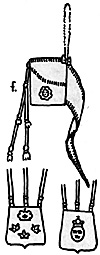 Lifregementebrigadens husarcorps (Fig
7): Mirliton black with a yellow flame, plume white,
border on cap and flame a black fringe (Fig 7f.), disc silver
with the arms of Sweden lacquered blue with three gold
crowns in the center, cords, raquettes and tassels yellow.
In 1813 the flame became black with white trim, and the
cords, raquettes and tassels blue and yellow mixed.
Dolman dark blue, collar and cuffs white, buttons brass,
braid white. Pelisse dark blue, fur light grey or white, braid
white, buttons brass, cuff lace white. Hussar sash blue and
yellow striped, runners yellow, cords yellow. Breeches
yellow ocre or buff skin. Boots black. Belts white.
Scabbard and sabre fittings steel, dragonne yellow.
Sabretache dark blue with three yellow Swedish crowns
surmounted by a yellow royal crown, straps white (Fig 7g.).
Saddle cloth dark blue trimmed white, three crowns in the
rear corner white (Fig 7d.). Portemanteau gray-green. In
1813 a new sabretache was worn. It was dark blue with
plate and crown in white metal, straps white (Fig 7i.).
Lifregementebrigadens husarcorps (Fig
7): Mirliton black with a yellow flame, plume white,
border on cap and flame a black fringe (Fig 7f.), disc silver
with the arms of Sweden lacquered blue with three gold
crowns in the center, cords, raquettes and tassels yellow.
In 1813 the flame became black with white trim, and the
cords, raquettes and tassels blue and yellow mixed.
Dolman dark blue, collar and cuffs white, buttons brass,
braid white. Pelisse dark blue, fur light grey or white, braid
white, buttons brass, cuff lace white. Hussar sash blue and
yellow striped, runners yellow, cords yellow. Breeches
yellow ocre or buff skin. Boots black. Belts white.
Scabbard and sabre fittings steel, dragonne yellow.
Sabretache dark blue with three yellow Swedish crowns
surmounted by a yellow royal crown, straps white (Fig 7g.).
Saddle cloth dark blue trimmed white, three crowns in the
rear corner white (Fig 7d.). Portemanteau gray-green. In
1813 a new sabretache was worn. It was dark blue with
plate and crown in white metal, straps white (Fig 7i.).
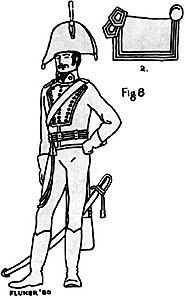 Karelska dragoncorps (Finnish) (Fig. 8):
Bicorne black, plume white, pompon crimson, braid and
button yellow. Jacket without tails dark blue,
shoulders/raps dark blue, lapels dark blue trimmed yellow,
collar patches yellow, buttons white, lace on the base of the
jacket yellow. Neck cloth black. Sash and cords yellow.
Belts yellow ocre or buff, buckles brass. Breeches yellow
ocre or buff skin. Boots black. Gloves yellow ocre.
Sabretache black without ornaments, straps yel low
ocre or buff. Scabbard and sabre fittings steel, dragonne
black. Saddle cloth and pistol covers yellow trimmed
with two white bands, portemanteau yellow (Fig 8a.). NOTE:
This regiment was disbanded in 1809.
Karelska dragoncorps (Finnish) (Fig. 8):
Bicorne black, plume white, pompon crimson, braid and
button yellow. Jacket without tails dark blue,
shoulders/raps dark blue, lapels dark blue trimmed yellow,
collar patches yellow, buttons white, lace on the base of the
jacket yellow. Neck cloth black. Sash and cords yellow.
Belts yellow ocre or buff, buckles brass. Breeches yellow
ocre or buff skin. Boots black. Gloves yellow ocre.
Sabretache black without ornaments, straps yel low
ocre or buff. Scabbard and sabre fittings steel, dragonne
black. Saddle cloth and pistol covers yellow trimmed
with two white bands, portemanteau yellow (Fig 8a.). NOTE:
This regiment was disbanded in 1809.
1813-1814 CAMPAIGNS
The following cavalry regiments participated in the 1813- 1814 Campaigns in Germany and Belgium, the number in parenthesis is the number of squadrons present during the campaigns:
- Lifgardet till Hast (5)
Smalands latta dragonregemente (6)
Lifregementsbrigadens kyrassiercorps (4)
Skanska husarregemente (6)
Mornerska husarregemente (6)
Skanska karabinjarregemente (4)
SOURCES
Drakt och Uniform. Eric Bellander. Stockholm, 1973. Sveriges Forvars. C.W. Kleen and E.H.K:son Bjorn. Stockholm, 1927.
Finnish Army Museum. Helsinki, Finland.
Swedish Cavalry. A series of plates and text by Roger Forthoffer.
Finska Kriget 1808-1809. C.O. Nordensvan. Stockholm 1898.
Back to Table of Contents -- Courier Vol. 2 #3
To Courier List of Issues
To MagWeb Master Magazine List
© Copyright 1980 by The Courier Publishing Company.
This article appears in MagWeb (Magazine Web) on the Internet World Wide Web.
Other military history articles and gaming articles are available at http://www.magweb.com